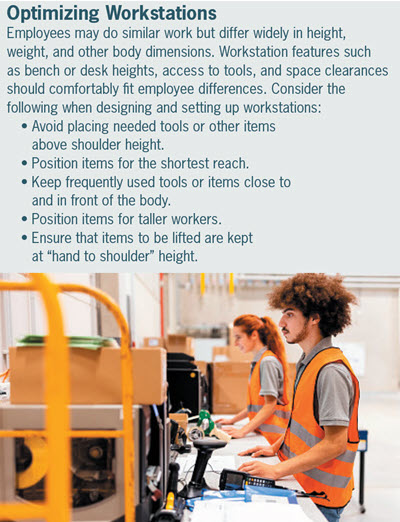
Reducing injuries, increasing productivity, and improving employee health and well-being
What happens if an employee has an ill-fitting workstation that puts too much pressure on the wrist or lower back due to repetitive movements or bending? It’s possible that a musculoskeletal disorder (MSD) could occur. MSDs are a major contributor to workplace injuries, often accounting for the highest accident frequency and severity costs for many companies. OSHA cites that MSDs or ergonomic injuries have direct costs of $15 to $20 billion annually.
major contributor to workplace injuries, often accounting for the highest accident frequency and severity costs for many companies. OSHA cites that MSDs or ergonomic injuries have direct costs of $15 to $20 billion annually.
According to a 2022 PMA Companies manufacturing study, “Strain or Injury by” claims cause the majority of musculoskeletal injuries and are the #1 loss area for PMA insurance clients (policy years 2016-2020). Strains account for 42% of claim frequency and 39% of total incurred dollars.
Types of strain claims vary but are classified by physical actions such as lifting, pushing/pulling, repetitive motion (including carpal tunnel syndrome), twisting, using a tool or machine, reaching, holding or carrying, wielding, or throwing.
How Ergonomics Can Help Prevent MSDs
Ergonomics is the science of fitting the workstation, task, or tools to the worker to improve productivity and reduce injury potential. It is a field of study that delves into designing tools and tasks to be compatible with the human body’s physical capabilities and limitations.
The goal of any safety and health program is to prevent injuries and illnesses by removing their causes. With ergonomics, this goal is achieved through eliminating or reducing worker exposure to conditions that lead to MSDs and related injuries and illnesses.

PMA Approach to Ergonomic Services
Our Ergonomic Strain Reduction Process engages clients in analyzing, reducing, and tracking reductions in frequency rates and loss costs associated with strain-related claims. The PMA Ergonomics Competency Certification Program helps to ensure our consultants are highly skilled in identifying problems and solutions for your ergonomic challenges.
PMA Risk Control assists our clients with the following:
- Identifying problem job tasks by analyzing loss data.
- Understanding the nature of each job and its hazards by breaking the job into specific steps to understand what employees do, how they do it, and why.
- Leveraging nationally and internationally recognized assessment tools to identify and quantify ergonomic risk factors.
- Taking unique measurements that help to assess risk such as determining object weights, forces required to push, pull or grip objects, distances objects are carried, as well as frequency and duration of job tasks.
- Providing an assessment report that identifies risk factors and provides practical solutions.
- Consulting on developing and implementing ergonomic improvements.
In addition to onsite consulting services, PMA offers an on-demand client learning site for ergonomics and strain reduction with access to our Office Ergonomics Assessment Tools and training.
If you have any questions or would like additional information, please contact your local PMA Risk Control Consultant or reach out to us at heretohelp@pmagroup.com.
IMPORTANT NOTICE
The information and suggestions presented by PMA Companies in this risk control technical bulletin are for your consideration in your loss prevention efforts. They are not intended to be complete or definitive in identifying all hazards associated with your business, preventing workplace accidents, or complying with any safety related or other laws or regulations. You are encouraged to alter the information and suggestions to fit the specific hazards of your business and to have your legal counsel review all of your plans and company policies. PMA Companies and Old Republic Companies do not provide legal advice and the information and suggestions in this bulletin should not be considered as such.

 major contributor to workplace injuries, often accounting for the highest accident frequency and severity costs for many companies. OSHA cites that MSDs or ergonomic injuries have direct costs of $15 to $20 billion annually.
major contributor to workplace injuries, often accounting for the highest accident frequency and severity costs for many companies. OSHA cites that MSDs or ergonomic injuries have direct costs of $15 to $20 billion annually.



